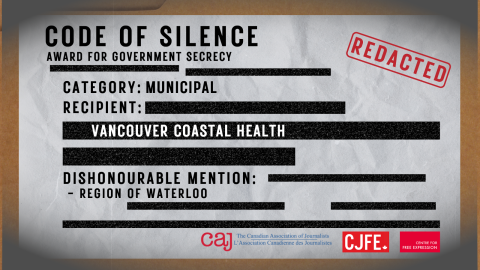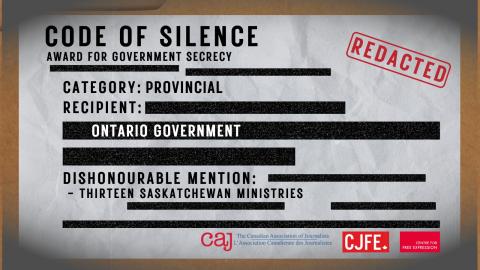‘Arms-length’ infrastructure agencies and citizen disempowerment
Many groups in the Greater Toronto Area are challenging Metrolinx’ ambitious and largely evidence-free transit plans, in terms of transparency and accountability.
Metrolinx is a very powerful agency spending many billions of public money. Like most other arms-length boards and agencies, it was structurally set up to diminish accountability -- to municipalities and also to citizens.
It was created in 2006 by the Ontario government, then Liberal, to ‘coordinate’ transit across municipalities. But it has excluded both elected municipal officials and municipal transit staff from its decision-making. As for the citizenry, Metrolinx, like its sister, Infrastructure Ontario (set up in 2003), it was created with tools used by neoliberal politicians all over the world to escape the usual mechanisms of ministerial accountability.
Metrolinx has gained unprecedented powers under the Doug Ford regime: Ford’s Building Transit Faster Act abolished many municipal powers as well as proper community consultations and environmental assessments. The Act also gives Metrolinx the power to seize any land or any structures that lie within 30 meters of its designated transit corridors, which in many places balloon out to several kilometers. In June 2021, every house on my Leslieville street got a formal notice saying that Metrolinx has the power to tear down any porches or vegetation on our own front yards that Metrolinx wants to remove. The rail corridor previously owned by CN, on which Go and Via trains run, is far more than 30 meters from the vast majority of our tiny front yards.
It is indeed slow and even painful to build transit if one follows the cumbersome procedures and consultations required by municipalities. But there is such a thing as going to the other extreme, to authoritarian top-down planning.
The so-called Ontario Line is the main project on Metrolinx’s drawing board today. All authoritarian leaders, from the Pharaohs to French Presidents, like to have a signature infrastructure project, and this is Doug Ford’s. It is, or is planned to be, a 16 km driverless subway, not compatible with the existing subway, that will go from Ontario Place in the far west of the city through downtown (below Queen Street) and then east and north along the Don Valley. Metrolinx’s casual announcement that the very busy intersection of Yonge and Queen would be closed for four years or more, supposedly because tunnelling under Queen Street was preferred to tunnelling under stores, gives a glimpse of the agency’s attitude towards the public good.
‘Don’t Mess with the Don’, an environmental group, is fighting against a proposed Ontario Line lay-over facility for trains in the Don Valley. Some folks at Thorncliffe Park (an overwhelmingly immigrant and heavily Muslim community) are challenging the expropriation of the mall where Iqbal Halal Foods is the anchor tenant. They also recently objected to the deal reached between Metrolinx and the Thorncliffe mosque, which gives the mosque $50 million in exchange for renouncing its legal status as a mosque (which, they say, is contrary to Islamic law
On its part, the Save Jimmy Simpson group in South Riverdale has put out many clever social media posts and street posters saying that the Ontario Line should be buried in the 1.6km stretch from Eastern Ave. to Gerrard Street, instead of being taken over-ground for that stretch (which has 6 very old bridges that will need to be rebuilt). In January 2022, the group documented Metrolinx’s clear-cut of trees and bushes along the train corridor – a tree-clearing operation carried out without a prior environmental assessment.
The struggles to hold Metrolinx and the Ford government accountable extend well beyond the old city of Toronto. People in Thornhill, led by Peter Palframan, say that the extension of the Yonge subway north of Steeles should be returned to its originally planned route along Yonge, where development is already concentrated, instead of being re-routed through an area that may prove advantageous to developers. In December 2021 Mr Palframan appeared before the Markham Development Services Committee saying that Metrolinx’s apparent concession to protesters --their statement that the revised Yonge subway extension would involve tunnelling only under 20 homes, not 40-- was misleading, because 15 additional homes would have their yards tunnelled.
People from Thornhill went down to Queen’s Park on October 6, 2021, for a multi-group rally against Metrolinx’s bad planning and its lack of transparency, which got little coverage as news media remained focused on COVID.
Since communities’ experiences being ignored, whose interests are driving transit infrastructure decisions? NDP MPP Peter Tabuns, whose riding is due to be heavily affected, has said that what the Ford government calls ‘transit-oriented development’ is really ‘developer-oriented transit.’ On some Metrolinx drawings of the imagined future, there are hugely tall buildings built over new transit stops, and the agency and the Ford government have mused that developers, given considerable development rights, will pay for the new stations, though no specifics have been announced for any site.
Some information on Metrolinx can be gleaned in Ontario Auditor General reports and from court documents arising from the numerous lawsuits involving Metrolinx. This hard-to-come-by information strongly suggests that when ministries of public works were replaced by arms-length infrastructure agencies, much was lost in terms of transparency and accountability.
In theory, Metrolinx is accountable to the Ontario Ministry of Transportation (MOT) and through that minister to the citizens of the province. However, no annual reports from the agency to the minister are available on the MTO website (which does have a tab for ‘Metrolinx’, but that just takes one to the Metrolinx website). Information about the financial accounts of the agency is even scarcer.
For example, I was unable to find out how much public money has gone to lawyers defending Metrolinx in its frequent court battles: there is no figure in the annual ‘financial statement’ on the Metrolinx website for F2019-20 for legal fees. There is a global figure of over $328 million for “Supplies and services”, but buying train cars, buying cement, hiring global consulting firms like Accenture, and paying Bay Street lawyers should not be merged in a single line item.
Legal databases, thankfully, are public. Through them we know that in the very recent past Metrolinx has been involved, mainly as a defendant, in 22 lawsuits which resulted in one Ontario Superior Court decision, and at least 9 in Ontario’s Divisional Court. The sheer number of court decisions suggests that Metrolinx is not willing to use mediation or arbitration, the normal route for commercial contract disputes. Well-informed rumour has it that developers and construction firms are not keen on bidding for any of the sections of the Ontario Line that are supposed to be tendered. The recent fight between the Eglinton Crosstown consortium, Crosslinx, and Metrolinx has likely generated mistrust even in Ford’s favoured private sector.
In May 2021, a judge adjudicating the dispute between Crosslinx (the contractor) and Metrolinx over extra costs on the Eglinton LRT line wrote unusually acerbically to cast aspersions on Metrolinx’s argument that COVID did not constitute an emergency for purposes of the contract. Metrolinx started by appealing the judge’s decision (a big waste of public money on legal fees, given the obvious flaws in the “COVID is not an emergency” argument), but eventually settled for a few hundred million –claiming that the amount was already in their budget, in a previously unknown “contingency fund” which must have been the size of Australia, but whose amount was not revealed by CEO Phil Verster to local transportation reporters.
This was no one-off. In 2018, Crosslinx had won an earlier lawsuit, after which Metrolinx paid $237 million –to the dismay of the provincial Auditor General, who said there was no justification for that particular amount.
So, who’s in charge of this monster? When Kathleen Wynne was premier of Ontario, Liberal corporate lawyer par excellence and former U of T President Rob Pritchard was the CEO. But when Ford got elected in 2018, Pritchard immediately resigned (showing the political nature of public agency executive recruitment). He was replaced by South African engineer Phil Verster Verster, infamous in his previous job running privatized rail in Scotland. Verster earns a $750,000-plus salary (but unlike rank and file public servants, top Metrolinx managers have their salaries supplemented by ‘performance payments’ not listed on the provincial public sector sunshine list.
On Metrolinx’s website, we can see impressive photos of the tunnel boring machines that have been digging up Eglinton Avenue for years now. But we cannot get any accounts.
To find out how the Eglinton Crosstown is being financed, one has to turn to the trade magazine Project Finance. The breakdown was: $95.4 million ‘sponsor equity’, that is, public cash; $506.4 million ‘bank debt’ (perhaps the Bank of Nova Scotia, listed as a ‘financial advisor’ for the project); and last but not least, $731.85 million in bonds for the project, issued in 2015. Individuals might unknowingly own some of these bonds via their mutual funds and ETFs but such bonds are mainly sold privately to institutional investors.
The $732.85m in bonds issued in 2015 by the Crosslinx consortium (whose lead partner is SNC Lavalin) had an interest of either 4.55% or 4.65%. This at a time when the government (according to the Ontario public accounts website) was paying only between 1.1% and 2.18% on its bonds. So much for public-private partnerships being less wasteful.
The province of Ontario, and indeed urban Canada, do need billions spent on public transit. But ‘transit done right’ is Canadians need, not just any transit at any cost, environmental or financial.
Local groups have arisen up and down the Ontario Line to fight against bits of the overall plan. But such groups cannot on their own fulfil the civic duty we all have, regardless of where we live, to call to account politicians responsible for the arms-length agencies spending public money behind closed doors with no ministerial accountability. The much-vaunted Ontario infrastructure model, which the Liberals euphemistically called “Alternative Finance and Procuring’” to avoid the charged term “public-private partnership”, is piling up intergenerational debt on people who are not yet old enough to vote while failing to respond to the Auditor General’s calls for greater accountability, never mind citizen pressure.



